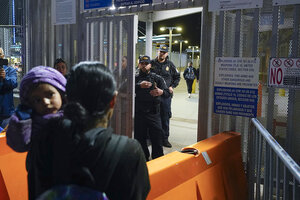What US asylum changes mean

Paula, of Guatemala, asks U.S. officials about new asylum rules at the San Ysidro Port of Entry on May 11, 2023, in Tijuana, Mexico.
Gregory Bull/AP/File
Violence, human rights abuses, and persecution have forced a record-breaking number of people around the world to flee their homes – some 110 million, according to a United Nations report released last week. The United States is traditionally a global leader in offering refuge and last year received the most asylum applications of any country.
Yet a Biden administration rule finalized last month limits access to asylum at the southern border. Individuals may now be disqualified for asylum unless they meet new conditions like presenting themselves at a port of entry with an app-arranged appointment or first seeking protection unsuccessfully in a transit country. The changes have provoked a range of critics: Both immigrant advocates and Republican-led states have sued the government, separately, hoping to halt what they argue is an unlawful policy.
All this stirs debate about how the U.S. should consider its obligations to people seeking safety here — backdropped by the need to reform the country’s broken immigration system. The Monitor explores what the new developments entail with some historical background.
Why We Wrote This
The United States, traditionally a leader in offering refuge, received the world's most asylum applications last year. A new rule that limits access to asylum is stirring debate.
How do refugees differ from asylum seekers?
Refugees and asylum seekers are similar – both groups flee their countries seeking safety. They may apply for protection due to persecution or fear of persecution based on race, religion, nationality, political opinion, or membership in a particular social group. The key difference comes in the way they seek relief.
Refugees apply while outside the country; asylum seekers must be present in the U.S. to apply. The government caps the maximum number of annual refugee admissions (125,000 this fiscal year). There is currently no numerical limit, though, on asylum seekers.
Yet limiting the flow of asylum seekers and their access to apply is “exactly what the Biden administration is trying to do,” with their new system to manage demand, says Yael Schacher, director for the Americas and Europe at the advocacy group Refugees International. She’s writing a book on asylum history in the U.S.
“Since the 1920s, we’ve had immigration quotas,” she adds. “Asylum is the outlier.”
What does the new asylum rule entail?
Under international and American law, individuals may seek asylum in the U.S. no matter how they enter – even if they cross the border unlawfully between official ports.
But the new regulation narrows access to asylum. The government, which anticipated a major border influx that has yet to arrive, says the changes encourage noncitizens to use “orderly, lawful pathways” to enter the U.S. and avoid overwhelming migrant processing and border facilities.
Announced May 10, a day before pandemic restrictions on asylum were set to expire, the rule creates a legal presumption that noncitizens who enter between now and May 2025 are ineligible for asylum, unless they meet one of multiple new exceptions.
Generally, if an asylum seeker isn’t eligible for advance permission to arrive and seek parole (a temporary state for noncitizens without the promise of long-term residence) they can try scheduling an initial appointment with U.S. officials at a port of entry through a controversial phone app called CBP One. Otherwise, to cross the border and seek asylum, they need to have sought and been denied protection in a prior country they traversed. Carve-outs include certain threats to safety, and unaccompanied children are exempt.
And yet, the policy “is not an asylum ban,” Secretary of the Department of Homeland Security Alejandro Mayorkas told ABC last month. “We have a humanitarian obligation as well as a matter of security to cut the ruthless smugglers out.”
Critics draw similarities to former President Donald Trump’s asylum policies that were blocked in court. And President Joe Biden isn’t the first Democrat to take aim at border crossings, points out Carl Bon Tempo, associate professor of history at the University at Albany.
“The Clinton administration in the early 1990s [played] a key role in the militarization of the border,” says the co-author of “Immigration: An American History.”
What explains the legal challenges?
The lawsuits offer competing views of the new asylum rule: too strict versus not strict enough.
A day after the final rule was announced, immigrant advocacy groups sued the government through a federal court in California. The rule “would bar vulnerable people from asylum for reasons wholly unrelated to the strength or urgency of their need for protection under our laws,” reads the complaint filed by the American Civil Liberties Union.
A lawsuit filed by Texas, on the other hand, also calls the new rule unlawful but centers on the phone app. The state claims that the rollout of the app, which allows for initial appointments at ports of entry but does not constitute an asylum application, amounts to the government “inviting” immigrants into border communities where they’ll strain public resources.
“The Biden Administration’s attempt to manage the southern border by app does not meet even the lowest expectation of competency and runs afoul of the laws Congress passed to regulate immigration,” it reads.
Similar concerns echo in a lawsuit filed by 18 additional GOP-led states at a federal court in North Dakota, which also challenges the expanded use of parole. The government, meanwhile, defends its decisions, citing a drop in border crossings since mid-May.
Secretary Mayorkas and others have called on Congress to pass critical immigration reforms, but bipartisan consensus has proved elusive.
Much of the politics of asylum has “become intermixed with the politics of unauthorized immigration,” more broadly says Prof. Bon Tempo.

